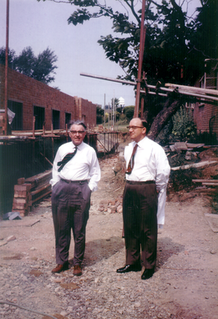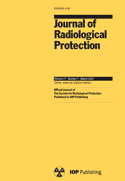 W
WCaptain John Henry Ebersole, M.D., MC USN a pioneer in submarine medicine and radiation oncology, selected by Admiral Hyman G. Rickover to serve as medical officer aboard the US Navy's first two nuclear powered submarines, the USS Nautilus and the USS Seawolf. He was the radiologist for NASA that screened the Mercury Seven astronauts for Project Mercury. Ebersole was the radiologist responsible for the x-rays taken during the autopsy of John F. Kennedy on 22 November 1963 at Bethesda Naval Medical Center.
 W
WA fallout shelter is an enclosed space specially designated to protect occupants from radioactive debris or fallout resulting from a nuclear explosion. Many such shelters were constructed as civil defense measures during the Cold War.
 W
WA Geiger counter is an instrument used for detecting and measuring ionizing radiation. Also known as a Geiger–Müller counter, it is widely used in applications such as radiation dosimetry, radiological protection, experimental physics, and the nuclear industry.
 W
WA glovebox is a sealed container that is designed to allow one to manipulate objects where a separate atmosphere is desired. Built into the sides of the glovebox are gloves arranged in such a way that the user can place their hands into the gloves and perform tasks inside the box without breaking containment. Part or all of the box is usually transparent to allow the user to see what is being manipulated. Two types of gloveboxes exist. The first allows a person to work with hazardous substances, such as radioactive materials or infectious disease agents, and the second allows manipulation of substances that must be contained within a very high purity inert atmosphere, such as argon or nitrogen. It is also possible to use a glovebox for manipulation of items in a vacuum chamber.
 W
WLouis Harold Gray was an English physicist who worked mainly on the effects of radiation on biological systems. He was one of the earliest contributors of the field of radiobiology. A summary of his work is given below. Amongst many other achievements, he defined a unit of radiation dosage which was later named after him as an SI unit, the gray.
 W
WThe Health Physics Society (HPS) is a nonprofit scientific professional organization whose mission is excellence in the science and practice of radiation safety. It is based in the United States and the specific purposes of the society's activities include encouraging research in radiation science, developing standards, and disseminating radiation safety information. Society members are involved in understanding, evaluating, and controlling potential risks from radiation relative to the benefits.
 W
WThe International Radiation Protection Association (IRPA) is an independent non-profit association of national and regional radiation protection societies, and its mission is to advance radiation protection throughout the world. It is the international professional association for radiation protection.
 W
WJournal of Radiological Protection is a quarterly peer-reviewed scientific journal covering radiobiological research on all aspects of radiological protection, including non-ionizing as well as ionizing radiations. It is the official journal of the Society for Radiological Protection and published on their behalf by IOP Publishing. It was established in 1981 as the Journal of the Society for Radiological Protection, before obtaining its current name in 1988. The editor-in-chief is Richard Wakeford.
 W
WJuno Radiation Vault is a compartment inside the Juno spacecraft that houses much of the probe's electronics and computers, and is intended to offer increased protection of radiation to the contents as the spacecraft endures the radiation environment at planet Jupiter. The Juno Radiation Vault is roughly a cube, with walls made of 1 cm thick titanium metal, and each side having an area of about a square meter. The vault weighs about 200 kg (500 lbs). Inside the vault are the main command and data handling and power control boxes, along with 20 other electronic boxes. The vault should reduce the radiation exposure by about 800 times, as the spacecraft is exposed to an anticipated 20 million rads of radiation It does not stop all radiation, but significantly reduces it in order to limit damage to the spacecraft's electronics.
 W
WA lead castle, also called a lead cave or a lead housing, is a structure composed of lead to provide shielding against gamma radiation in a variety of applications in the nuclear industry and other activities which use ionizing radiation.
 W
WLead shielding refers to the use of lead as a form of radiation protection to shield people or objects from radiation so as to reduce the effective dose. Lead can effectively attenuate certain kinds of radiation because of its high density and high atomic number; principally, it is effective at stopping gamma rays and x-rays.
 W
WThe linear no-threshold model (LNT) is a dose-response model used in radiation protection to estimate stochastic health effects such as radiation-induced cancer, genetic mutations and teratogenic effects on the human body due to exposure to ionizing radiation. The model statistically extrapolates effects of radiation from very high doses into very low doses, where no biological effects are observed. The LNT model lies at a foundation of a postulate that all exposure to ionizing radiation is harmful, regardless of how low the dose is, and that the effect is cumulative over lifetime. The model ignores existing DNA repair mechanisms and is not supported by biological evidence and deprecated by international bodies specializing in radiation protection.
 W
WThe proportional counter is a type of gaseous ionization detector device used to measure particles of ionizing radiation. The key feature is its ability to measure the energy of incident radiation, by producing a detector output pulse that is proportional to the radiation energy absorbed by the detector due to an ionizing event; hence the detector's name. It is widely used where energy levels of incident radiation must be known, such as in the discrimination between alpha and beta particles, or accurate measurement of X-ray radiation dose.
 W
WRadioactive contamination, also called radiological contamination, is the deposition of, or presence of radioactive substances on surfaces or within solids, liquids or gases, where their presence is unintended or undesirable.
 W
WA scintillation counter is an instrument for detecting and measuring ionizing radiation by using the excitation effect of incident radiation on a scintillating material, and detecting the resultant light pulses.
 W
WThe sievert is a derived unit of ionizing radiation dose in the International System of Units (SI) and is a measure of the health effect of low levels of ionizing radiation on the human body. The sievert is important in dosimetry and radiation protection, and is named after Rolf Maximilian Sievert, a Swedish medical physicist renowned for work on radiation dose measurement and research into the biological effects of radiation.
 W
WRolf Maximilian Sievert was a Swedish medical physicist whose major contribution was in the study of the biological effects of ionizing radiation.
 W
W(Radiation) skyshine describes the ionizing radiation emitted by a nuclear technical or medical facility, reaching the facility's surroundings not directly, but indirectly through reflection and scattering at the atmosphere back to earth's surface. This effect can happen when the shielding barrier around the source of radiation is open at the top. In a wider sense, skyshine also describes radiation reflected off the ceiling inside a nuclear facility.
 W
WSurvey meters in radiation protection are hand-held ionising radiation measurement instruments used to check such as personnel, equipment and the environment for radioactive contamination and ambient radiation. The hand-held survey meter is probably the most familiar radiation measuring device owing to its wide and visible use.
 W
WLauriston S. Taylor was an American physicist known for his work in the field of radiation protection and measurement.